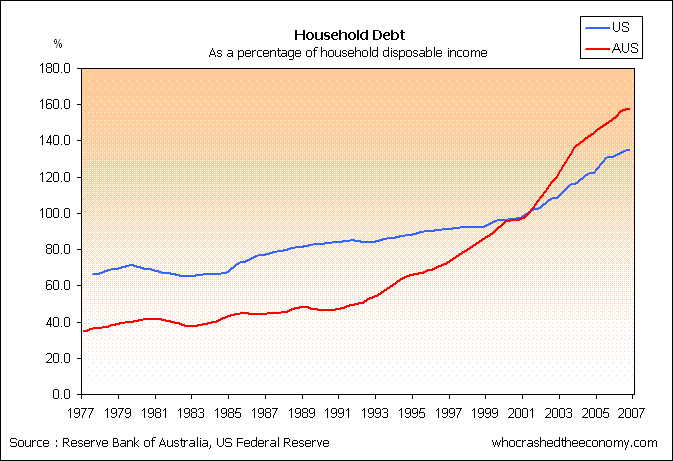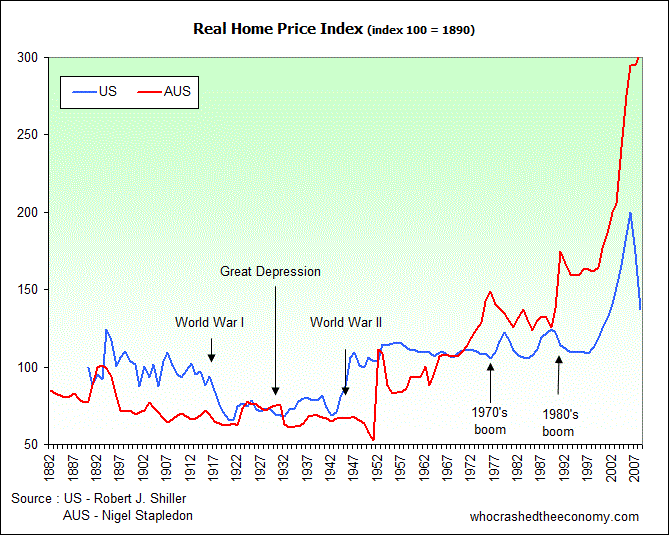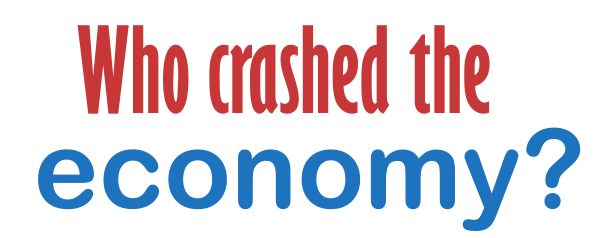While on informal leave at Kirribilli House last week, Prime Minister Kevin Rudd crafted his essay titled “The Building Decade: The Long, Hard Road to Sustainable Economic Recovery” due to be published in the Herald today. While it impressively demonstrates a solid understanding of the causes, it does raise some questions as to if anything has been deliberately left out.
The essay begins with Rudd’s indication the current recession is the worst since the Great Depression.
WHEN Australia last experienced a global recession worse than the current crisis, Jim Scullin and Joe Lyons were prime ministers of Australia, Don Bradman had just begun his Test cricketing career and Charles Kingsford Smith had just made his first flight across the Pacific.
He attributes the cause of this global financial crisis to a decade of excess where many consumers lived beyond their means.
Australian consumers also spent up big. Between 1996 and 2007, there was a 460 per cent increase in credit card debt, a 340 per cent increase in household debt, a 450 per cent increase in corporate debt and a 200 per cent increase in net foreign debt.

These comments lead to a discussion of asset prices, but Rudd carefully distances himself from confirming skyrocking housing asset prices in Australia, using the phrase “in several countries.”
Second, these debts were racked up on the back of skyrocketing asset prices. In several countries, stock prices and house values soared far above their true long-term worth, creating paper wealth that millions of households used as collateral for their growing debts.

This crisis has shown we have reached the limits of a purely debt-fuelled global growth strategy.
With the causes documented and out of the way, there is comment about the quick and decisive action taken and what lies ahead for us all now there are “green shoots” appearing.
As the crisis took hold, responsible governments around the world were forced to step in to stabilise fractured financial markets and to support growth and jobs through unprecedented fiscal stimulus.
He indicates the truth, however, is the world is still a long way from recovery.
Mountains of global public and private debt, global imbalances, and a weakened global financial system will drag on global growth for a long time.
As world-renowned financial columnist Martin Wolf has written: “Those who expect a swift return to the business-as-usual of 2006 are fantasists. A slow and difficult recovery, dominated by de-leveraging and deflationary risks, is the most likely prospect.”
With phase one, the unprecedented economic stimulus all but complete, Rudd then talks about the withdrawal.
We must begin to plan for a properly globally co-ordinated withdrawal of the extraordinary interventions we implemented in the first phase of the crisis.
But it is a delicate balancing act. An early withdrawal of stimulus can endanger confidence and economic recovery.
Preparation for phase two is primarily focused on increased productivity with regulatory and competition reform, infrastructure, innovation, skills, tax, health and aging, climate change and water also gaining worthy mention.
Rudd indicates phase two will also see unemployment continuing to rise, even after growth returns. Over the next 18 months, rising growth will inevitably cause interest rates to rise off their record lows and as the global economy improves, demand for commodities will pick up, causing prices to rise. Remember this will be a slow recovery.
Fourth, the Government’s strategy to return the budget to surplus will involve some painful and unpopular decisions that will affect many Australians.
The question remains, if we were spending more than we earn, and after reaching the limits of a purely debt-fuelled global growth strategy and the government applies an unprecedented fiscal stimulus, how can you have a withdrawal that doesn’t endanger confidence and economic recovery?
One thing Kevin Rudd surely has right :
The economic recovery, however, will be a long, tough and bumpy road with many twists and turns.
Only time will tell what the many twists and turns will be. Just don’t mention housing.
» Rudd’s recipe for recovery – The Sydney Morning Herald, 25th July 2009.
» The road to recovery – Business day, 25th July 2009.

The real home price index graph is simly astounding – the reversion to mean will be the most devestating economic event in Australia’s history
Miller, I
I’m with Steven Keen on this one.
Super-low interest rates are adding fuel to the property market …
Fleur Leyden
July 18, 2009 12:00am
THOUSANDS of Victorians are lining up each week to get back into the property market or to make their first foray into home ownership.
There is a sense of urgency out there. After all, we are told the national median house price is now just $520 off the record set in February last year before the economic rot set in.
And Melbourne is leading the way, with a 6.1 per cent rise in prices in the first five months of the year and auction clearance rates above 80 per cent for the past nine weeks.
Buyers and sellers, buoyed by interest rates at 50-year lows, are paying close attention, wondering whether it’s time to exit the rental market to become a homeowner, upsize their home or buy an investment property.
Significantly, many are cashed-up courtesy of the first-home buyer’s grant.
About 98,000 grants have been doled out since the Rudd Government doubled the size from $7000 to $14,000 for existing dwellings and tripled it to $21,000 for new houses last October.
On top of that a state grant can take the level of help for first home buyers in regional Victoria to a princely $36,500.
But it could all be a recipe for a property bubble, according to some economists.
Interest rates, they say, will not stay low forever, unemployment is rising and the government largesse has a time limit. The boosted federal subsidy runs until the end of September, when grants will be scaled back to $10,500 and $14,000, before returning to $7000 for all dwellings next year.
“We now have without a doubt the most over-inflated property market on the planet – the only possible exception might be the Netherlands,” says Steve Keen, associate professor of economics and finance at the University of Western Sydney.
“It’s based on a huge level of gearing … and we’re encouraging people back into that market by encouraging them to take on more debt.”
Dr Keen, one of the country’s most bearish economic forecasters, says debt servicing costs are becoming so great that the ratio of house prices to incomes is unsustainable and Australia will copy Japan’s 1990s housing bubble in which prices dropped 40 per cent.
He says cuts to the grant could cause property prices to flounder.
“When the grant runs out you are going to find there’s a huge slump in the first home buyer’s proportion of the market and then, of course, supply and demand will push prices down.”
RBS chief economist Kieran Davies says the Reserve Bank faces a conundrum. On one hand, it wants to keep interest rates low to stimulate corporate lending and business activity, yet this also has the potential to spur borrowing by Australian consumers who are already among some of the most debt-laden in the world.
“I think the Reserve Bank probably would have liked – if it could – not to have cut mortgage rates so much and have helped companies out more.
“In terms of creating another bubble it would be quite alarmed if you eventually saw borrowing start to grow again at the rates you saw over recent years.”
Mr Davies says the overall trend of the property market is still obscured by the effect of the bulked up home owner’s grant, although there are “signs of life” in most sectors of the housing market.
He expects that, while the pared back grant and rising unemployment will take the shine off the property market in the second half of this year, prices should improve again – helped by low interest rates.
HOWEVER, he warns that low interest rates are only temporary and borrowers – particularly first home buyers – should be working on the assumption that they will rise over the next three to five years.
“They should definitely be allowing for that in their calculations,” Mr Davies says.
“I’d say the Reserve Bank would probably be a bit concerned.
“You wouldn’t want to see some first home buyers take on too much debt, given unemployment is likely to head higher and eventually interest rates will go back to more normal levels.”
AMP Capital Investors chief economist Shane Oliver is optimistic that there will be enough support left in the housing market once the grant is scaled back because the middle and upper ends of the market are likely to take over from the lower end.
“On the one hand, we still have very expensive housing compared with the US, and we’ve got relatively high debt levels – which suggests prices should come off. We are also vulnerable with unemployment still rising,” he says.
“But against all that, with very low interest rates and the fact that we don’t have a housing oversupply, it’s hard to see a big fall in house prices occurring.”
Paul Braddick, head of property and financial system research at ANZ, is also positive about the fundamentals of the housing market, saying national house prices will still kick up by 4.5 per cent in 2010, underpinned by strong population growth and a shortage of supply.
“The main driver of falling house prices is when people are forced to sell – and in the US a very high proportion of sellers in the market over the last 18 months have been forced sellers,” Mr Braddick says.
“We haven’t had that level of forced selling in Australia.”
He says our property market escaped the turmoil that brought the US and other overseas markets unstuck because of relatively conservative lending practices by financial institutions to home buyers.
This meant our market was not riddled by bad debts to sub-prime, or high-risk, borrowers.
Mr Braddick says lending practices in Australia have become even tougher since the onset of the credit crunch, punching a hole in the argument that people who borrow now will come unstuck once interest rates begin to rise.
“Banks, when they are calculating whether borrowers can meet their repayments, will always include a buffer above what the interest rate is,” he says.
“Back at the peak of the market it was 150 basis points. It’s now generally around 225 basis points.”
But Dr Keen disagrees, saying the level of lending that’s going on to first-home buyers “smacks of lenders seeing a market opportunity”.
“The banks are caught up in this thing of not wanting to see house prices fall because they know their asset backing collapses,” he says.
Australians (the majority) are an embarrasment to the economic world, unable to understand basic numbers and math, they drive the country further and further towards an economic abyss. History also appears to be another weakness of their composition, perhaps viewing of the program “The Ascent of Money” should be manditory for all adults…… but even that won’t save them now.
The home price index should be causing major alarm for the government, instead they just distance themselves from the disaster to come….. the rest of the world having gone through their correction already will watch with popcorn in hand as the dumb Australian masses fall the hardest.
Personally I won’t shed a tear for anyone who recently bought a home prompted by the 1st home buyers grant.
Best of luck to all those “Boomers” who start selling on mass during the coming decades when they need to “release capital” into cash for living costs in retirement, oh how that will help keep prices inflated….. not.
I don’t mind a small gamble now and then to get the blood moving, but not when the odds are this bad and rising.